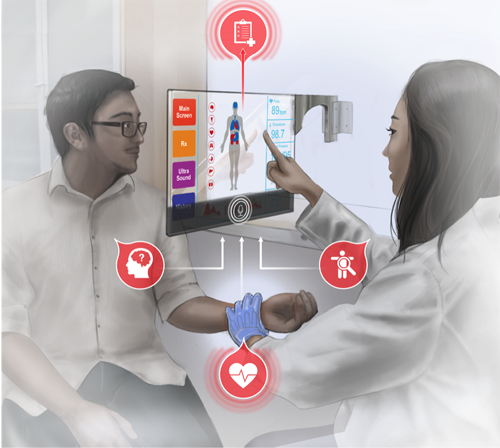10 Finalists Chosen For Dare-to-Dream Medtech Design Challenge (HaptiCare)
HaptiCare System How does the device work?
November 10, 2014
HaptiCare System |
How does the device work?The HaptiCare system humanizes technology in healthcare and enhances the doctor-patient relationship during visits. There are two symbiotic devices—the HaptiSense smart glove and the HaptiLink display. The HaptiSense glove replaces the cold, metallic tools used during an exam. Worn by physicians, it is activated by physical human contact. Sophisticated sensors embedded inside the glove interpret natural touch, sound, vocal, and gestural cues—like two fingers held to the wrist—to capture patients’ vitals, including heart rate, blood pressure, temperature, and subsurface acoustics. These patient vitals and information are wirelessly summarized onto the HaptiLink, a visual display and interactive learning platform. Placed directly between doctor and patient, both parties access and manipulate the transparent display. HaptiLink facilitates face- to-face interaction and dialogue between them. Text on each side of the display is oriented so both patient and doctor can read information from their respective sides. As both parties converse, the HaptiLink uses voice recognition algorithms to dynamically fill patient’s medical files; eliminating the need for doctors to hold clipboards or type into EMRs, allowing conversation to flow naturally. Before the patient leaves, they receive a detailed printout of their care plan, generated automatically by the HaptiLink system. What problem in healthcare does it solve?The Hapticare system promotes physical touch and engaged body language, increasing empathy between doctors and patients. By automating medical data entry, HaptiCare shifts the doctor’s attention back to the patient, and technology fades into the background. Patients take on a more participatory role, feeling ownership over their health information, eliminating uncertainty and confusion. By increasing the understanding and intimacy between doctor and patient, HaptiCare empowers and educates patients to better health outcomes. Why should the device be commercialized?Research proves patients who feel doctor empathy are more tolerant to pain and stress from illness. Doctors who empathize with patients make less medical errors, receiving fewer malpractice claims. Many doctors’ tools today create barriers in doctor/patient interaction: LCD screens detract from eye contact, cold exam tools intimidate, and cryptic charts are incomprehensible to laypeople Statistically, doctors spend 12 minutes with patients, half the time spent on paperwork. Even top-of-the-line EMR technology still requires keyboards, breaking contact with doctor/patient What inspired you to design this device?With 30 years experience designing medical products, Karten Design has spent countless hours talking to patients about their healthcare experiences. We’ve learned about the fear, intimidation, and confusion in clinical environments. Karten Design wanted to rethink the way in which doctors and patients interact in a digital age where technology and healthcare merge for the better.   |
You May Also Like



